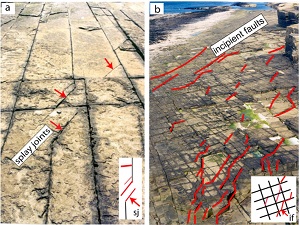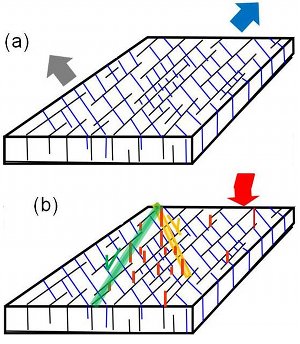| |||||||
|
|
|||||||
|
|
|||||||
| Faulting by Shearing of Orthogonal Sets of Joints | |||||||
|
Both sets of joints in an orthogonal pattern may be subjected to shearing if there is a rotation of the stress system or tilting of the medium. Whether one or both joint sets would slip depends on the resolved shear and normal stresses on the joint planes in two orientations and frictional resistence to slip along the joints. Figure 1a shows a case in which splays are formed diagonally to the up-and-down set on a wave cut pavement of flagstone cropping out in Caithness, northern Scotland. Figure 1b is a broader view of the pavement with incipient faults utilizing both the splays and the initial joints to form through-going small faults. Figure 2 depicts schematically the initial orthogonal joint pattern (a) and the subsequent shearing of both sets eventually leading to two through-going faults with dihedral intersection angle (b). Due to the angular geometry between adjacent segments, larger deformation will break the rock into smaller fragments via cataclastic deformation which may eventually lead to the formation of larger faults with more continuous slip surfaces. | |||||||
|
Readme | About Us | Acknowledgement | How to Cite | Terms of Use | Ⓒ Rock Fracture Knowledgebase |
|||||||

